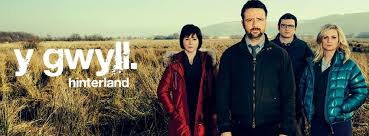| Y Gwyll-Fanfare for Fiction Factory |
Television Arts Feature |
| Fiction Factory , S4C , November 25, 2013 |
 A couple of years ago a starrily-cast piece of television drama gave off that air of inescapable anonymity; it is the surest sign that too many hands have been allowed a-dabbling. It prompted the most percipient of television writers to comment on TV drama that it “needs to become both more and less parsimonious about its productions; less authentic and obsessively realist, with less set- and actor-dressing, and more space given to scripts and good projects. The runs of British dramas are almost always too short, so the plots are squeezed into gaudy boxes of costumes and National Trust furniture.”
A couple of years ago a starrily-cast piece of television drama gave off that air of inescapable anonymity; it is the surest sign that too many hands have been allowed a-dabbling. It prompted the most percipient of television writers to comment on TV drama that it “needs to become both more and less parsimonious about its productions; less authentic and obsessively realist, with less set- and actor-dressing, and more space given to scripts and good projects. The runs of British dramas are almost always too short, so the plots are squeezed into gaudy boxes of costumes and National Trust furniture.” “Y Gwyll” might well have been conceived, composed and crafted as a direct counterpoint to that critique. The first episode earned a prompt welcome from the Editor of Wales Arts Review: “In an era when British television drama rarely gives itself to breathe we should be grateful, if not bemused, that it exists at all.” Now that the whole thing has been seen “Y Gwyll” over the whole series has distinguished itself on at least three counts. Firstly, it has avoided the “Broadchurch” scenario. That series was lifted by its luscious backdrops. (Memories are short and it is forgotten that “Broadchurch” got middling reviews while it was on- baggily tensionless with not a clue about the texture of a coastal town.) It would have been easy to shoot the Ystwyth and Rheidol valleys in their spring colours and make it into a heritage event. Back to Wales Arts Review: “Shot with real intelligence; simple, subtle and with both eyes focussed on the feeding of the atmospheric cloud over the piece” The treatment of Ceredigion is true. It is not the only version, but it is a true one. Upland buildings can have a tatterdemalion quality. The windfarm plot and the background conifers are reminders that National Park status was snatched away from the Cambrians in a last-minute manoeuvre. Of course, “Y Gwyll” on a television in Newport, or a CF or SA postcode, is not the same as the view from a SY23-postcoded location. The site of the caravan home on the cliff path is familiar. The creepy Guild is located in the much-loved, Davies-endowed former library of 1906. I have drunk at the “Penwyllt Arms”, visited the police station in its former role as the county archive. The day on which I first passed the home of Episode One murder victim Helen Jenkins was one to remember. A Land Rover came screeching along the beach with a shout to clear the area fast. The army was on its way to deal with an unexploded world war two mine that the shifting estuary sands had uncovered. As it happens the Second World War featured, the key to unravelling a plot far back in history. It made for a satisfying richness of texture, not to mention a hint of the Sarah Lunds in the detective’s doggedly digging further and further back to get at the truth, and all in the face of hostility from his superiors. The budget for “Y Gwyll” was tight- the handsome vehicle driven by Tom Mathias was on loan- but imagination anyhow cannot be bought. The locales were put to imaginative use. The Blodeuwedd tale played a chilly part. Devil’s Bridge was expanded to metaphorical effect. I will never bump over a cattle grid without a shudder of memory. There were a lot of pleasures to be had in the casting. Ifan Huw Dafydd was on familiar ground as an upland farmer but Mathew Gravelle was scarcely recognisable as a forest loner. Phylip Harries lurked in a sepulchral vehicle workshop. The camera lens has a very particular kind of eye. It looked deep into the eyes of leads Mali Harries and Richard Harrington, relished the chiselled lines on Matthias’ forehead. There was the odd loose end. In episode three the victim was identified via his DNA, a quick one-liner to keep the plot going. But it is also an unequivocal marker to the audience that he probably has a criminal record. That either needs incorporating or it is a loose end. Script editing is a tough discipline; every line needs to be put on trial for its life. It is a nervy business to create anything and hopefully nerves at S4C are well-settled. Wales Arts Review ended its appreciative essay with a note on the redundancy of cast and crew being obliged to shoot the whole thing twice. BBC4 nabobs are happy to broadcast subtitled series from across Europe, but when it comes to a programme from their own fellow citizens a different rule applies. |
Reviewed by: Adam Somerset |
This review has been read 3912 times There are 28 other reviews of productions with this title in our database:
|
